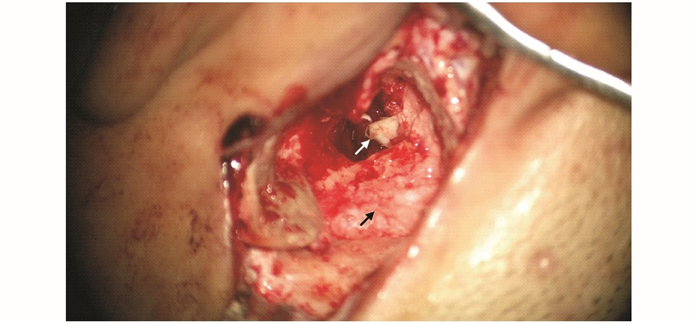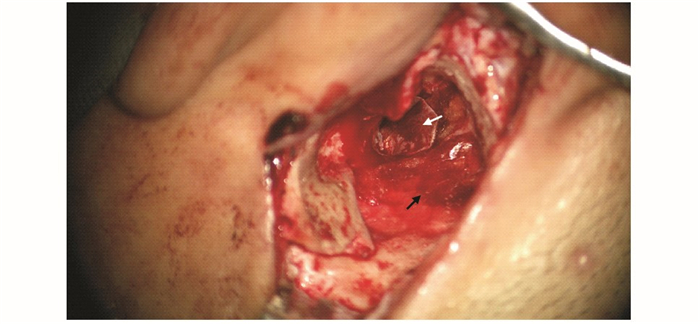-
摘要:目的 探讨骨粉填塞用于开放式改良乳突根治术的可行性和临床疗效。方法 回顾性分析北京协和医院2013年10月至2014年2月收治的12例因慢性化脓性中耳炎行开放式改良乳突根治术并采用骨粉行乳突腔填塞患者的临床资料。观察术后鼓膜和乳突腔形态, 并对术腔完全上皮化时间和术后听力改善情况进行统计学分析。结果 12例患者均干耳; 手术后鼓膜形态接近正常, 乳突腔体积明显缩小; 完全上皮化时间平均29.9 d。8例行人工听骨听力重建患者平均听力提高(11.7±1.8)dB, 听力重建效果好。结论 开放式改良乳突根治术术腔采用骨粉填塞法简便易行, 术腔表面光滑, 愈合时间缩短, 鼓膜形态良好, 听力重建效果佳。Abstract:Objective To investigate the clinical outcome of bone pate for mastoid obliteration after canal wall down mastoidectomy.Methods The clinical data of 12 patients who had undergone canal wall down mastoidectomy followed by bone pate obliteration in Peking Union Medical College Hospital from October 2013 to February 2014 were retrospectively analyzed. The post-operative morphologies of tympanic membranes and mastoid cavities were observed, and the complete reepithelialization time and improvement of hearing were analyzed.Results The mastoid cavities were completely reepithelialized in all 12 patients. The morphologies of tympanic membranes were nearly normal. The volumes of mastoid cavities were significantly reduced. The mean time of complete reepithelialization was 29.9 days. The air-bone gap value increased by (11.7±1.8) dB after the operation in 8 patients who had undergone hearing reconstruction.Conclusions Mastoid obliteration with bone pate after canal wall down mastoidectomy is a simple and convenient procedure that can easily make the mastoid cavity be well-shaped and reepithelialized, shorten the healing time, and achieve good hearing outcome.
-
Keywords:
- mastoidectomy /
- mastoid obliteration /
- bone pate /
- otologic surgical procedures
-
近年来,医学人文在我国医学领域备受瞩目。一方面,人文学者开始参与到医学教育与实践中,另一方面,医生也意识到了人文教育对现代医学的帮助,逐渐参与到医学人文的讨论中。医学人文在双方的共同推动下,已经成为医学教育不可或缺的组成部分。本文通过总结医学人文的发展历程,旨在为我国医学人文研究和教育提供一定帮助。
1. 医学人文的定义及内涵
文学、艺术和医学数据库(the Literature, Arts and Medicine Database,LitMed)对“医学人文”这一术语给出了广义定义:人文、社会科学和艺术及其在医学教育和实践中应用的交叉和多学科领域[1]。英国达勒姆医学人文中心将医学人文定义为“一个新兴的探索领域”,其运用人文和社会科学的观点探索医学中人的一面。综合多方观点,本文将医学人文定义为:借助人文、社会学科和艺术的理论、观点及方法,考察医学实践中的人文社会现象和规律的交叉学科群,其目的是跨专业考察疾病与个体、群体与社会的互动关系,解决医学实践中的人文社会困境,推进医学人文理论发展。
作为交叉学科群,医学人文是医学与人文、社会学科的交叉融合,其子学科包括医学史、医学伦理学和生命伦理学、医学人类学、文学与医学、叙事医学、医学心理学、医患沟通等学科。有学者从科学计量学角度,将医学人文的发展概括为三个阶段[2]:第一阶段(1900—1960年),主要倡导医学的博雅之学,是医学人文的起点;第二阶段(1960—1980年),随着《赫尔辛基宣言》的出现,掀起了生命伦理学的研究热潮;第三阶段(1980年至今),出现了医学史、叙事医学、医学人类学等方向,呈现出全球化和多元化的发展趋势。以上3个阶段的划分虽有其道理,但难以展现医学人文发展的全貌,本文将基于医学史、生命伦理学、医学人类学和叙事医学4个学科,总结医学人文的发展历程。
2. 医学人文的发展历程
从希波克拉底誓言到孙思邈的“大医精诚”,国内外种种研究迹象均表明,医学人文具有十分悠久的历史。然而,“医学人文”这一概念的正式提出却是在20世纪初。
1913年,法国医师人文学会成立,旨在推动医学界的古典研究,加强医学预科教育中被忽视的人文教育。1919年,美国医学家、著名人文学者威廉·奥斯勒发表了“旧人文与新科学”的主题演讲[3],并在演讲中提出了医学人文学者(medical humanists)这一概念。奥斯勒认为,医学的快速发展和专业化,极有可能带来负面影响,其倡导医学教育和人文学科应相互了解和促进。然而在此后的很长一段时间里,医学人文仅处于萌芽阶段。
2.1 医学史
医学史的研究由来已久,在19世纪甚至更早便存在医学史相关的讲座或演讲,但其目的是研究医学古典文学以获取医学经验。随着医学的科学化发展,医学史逐渐成为一门专业的学科。这一时期的代表人物是法国的夏尔·达朗贝里,他以实证主义思想引领了法国的医学史研究,使法国成为当时的医学史研究中心,并在1870年成为巴黎医学院的医学史教授。1901年,德国医学史学家卡尔·祖德霍夫创办了德国医学史学会。1904年,祖德霍夫在莱比锡大学创立了医学史研究所,并建立了图书馆,成为当时世界上医学史研究的榜样和中心[4]。此后,欧洲各国纷纷成立了国家级的医学史学会,并于1920年成立了医学史国际学会。美国于1925年成立了医学史学会,于1929年在约翰斯·霍普金斯大学医学院成立了医学史研究所[5]。到20世纪50年代,世界上很多医学院校都设置了医学史的研究机构。
此后,单纯的医学史研究转变为医疗社会史研究[6]。1966年,乔治·罗森在美国医学史学会第39次年会上强调了社会环境和社会结构在医学史研究中的重要性,并指出“患者在医学史中应拥有一个更加显著的位置”。1970年,英国成立了医疗社会史学会,1988年开始出版《医疗社会史》。史学家出身的研究人员走进了这一领域,专业的历史学家开始主导医学史研究。医学史开始关注疾病、健康、社会、患者和医生等多个方面,极大促进了医学史的发展,而美国和英国成为这一时期的医学史研究中心。美国芝加哥大学历史系教授威廉·麦克尼尔编著的《瘟疫与人》,英国曼彻斯特大学“科学、技术和医学史研究中心”教授普拉提克·查克拉巴提编著的《医疗与帝国》,伦敦维尔康医学史研究所的医学社会史教授罗伊·波特等编著的《剑桥插图医学史》等,都是耳熟能详的医学史作品。
2.2 生命伦理学
生命伦理学的运动为医学人文研究注入了充满活力的新鲜血液,是医学人文发展的里程碑事件。伦理学源自于二战后对德国纳粹分子开展的惨无人道的人体试验的反思。1946年《纽伦堡法典》问世,规定了人体试验的基本原则,作为国际上进行人体试验的行为规范。1964年,世界医学协会发表了《赫尔辛基宣言》,该宣言制定了涉及人的医学研究的道德原则,是包括以人作为受试对象的生物医学研究的伦理原则和行为规范。这两份文件的出台是生命伦理学上具有里程碑意义的事件,却并未得到应有的重视。如20世纪60年代的“反应停”事件曾一度在欧美日等地引起关注,美国议员亦曾试图推动药品试验知情同意法案,然而最终却趋于妥协。
1966年,哈佛医学院亨利·比彻教授在N Engl J Med发表了题为“Ethics and Clinical Research(伦理学与临床研究)”的文章,列举了22项涉及人体的试验,揭露了研究人员在人体试验中的权力滥用行为[7]。该文引起巨大轰动,对涉及人体试验的科研造成了剧烈冲击。同年美国成立了机构审查委员会,其核心是医生同行评议的监督。紧接着是器官移植领域的巨大突破,特别是心脏移植技术的出现,将医生推向了患者的对立面,进一步引发了稀缺医疗资源的合理分配问题。该事件推动哈佛大学成立了一个由医生组成的委员会,负责重新定义死亡标准,以脑死亡代替心脏死亡。
1970年,美国医生范·伦塞勒·波特首次提出了“生命伦理学(bioethics)”一词,认为生命伦理学是“一门生存的科学(science of survival),即把生物学知识和人类价值体系知识结合起来的新学科”[8]。1972年,美国媒体曝光了塔斯基吉梅毒试验,引起了公众对涉及人体医学研究的强烈不安。而1975年卡伦·安·昆兰案将生命伦理学运动推向了顶峰。1973年,美国成立了负责医学伦理调查的国家委员会,1978年改组为医学伦理问题研究总统委员会(the President's Commission for the Study of Ethical Problems in Medicine)。委员会的成立结束了医生一言堂的地位,将医学决策置于公众的监督之下。
生命伦理学运动起源于美国,随后在世界各国引起巨大反响。在这一运动中,以科研为目的、涉及人体的科研伦理和以治疗患者为目的的临床伦理逐渐被区分开来。随着医学科学技术的不断突破,生命伦理学研究的范围也逐渐扩大,如基因技术、人工智能、安乐死等问题的探讨。美国哥伦比亚大学教授戴维·罗思曼在《病床边的陌生人:法律与生命伦理学塑造医学决策的历史》一书中记录了美国二十世纪六七十年代生命伦理学运动的完整过程,并分析了这一事件背后政治、经济、科技、道德等错综复杂的原因[9],对了解这一时期的生命伦理学运动具有极大帮助。
2.3 医学人类学
1953年,美国学者考迪尔发表评论性文章《医学中的应用人类学》,标志着人类学开始明确关注卫生保健领域。随后,英国学者里杰斯特(1956年)、印度学者哈桑和普拉萨德(1959年)都曾在论文中使用了“医学人类学”一词。1963年, 斯科奇发表了论文《医学人类学》[10]。直到1972年, 美国医学人类学学会成为美国人类学协会的正式组织, 医学人类学才成为正式的学科。1977年,《医学人类学》杂志创刊。
医学人类学强调人的整体性,认为人是生物属性和文化属性的有机结合。医学人类学通过田野调查,分析各种疾病背后蕴含的文化含义,并进行解释。在医学人类学的研究中,以凯博文的研究最具影响力,他带来了医学人类学研究的范式转变。凯博文是哈佛大学医学院的精神病学与医学人类学教授,其对不同语境和条件下不同人群的疾痛体验进行了深刻体察,领会人生中无所不在的病痛和苦难,以疾痛解释模式分析背后的文化属性。他首倡以人类学方法重构欧美精神医学体系,探索以患者为主体的研究方法和诊疗手段[11]。如他在《疾痛的故事:苦难、治愈与人的境况》中分析许多饱受病痛折磨的患者,认为疾痛具有4种不同层次的意义:症状、文化、生活环境、解释与情绪,4种意义相互影响,导致了患者遭受的苦难。而在《照护》一书中,凯博文则记录了自己和患阿尔茨海默病妻子的10年经历。该书虽然不是学术著作,但其以独特的视角,从个体叙事的角度,展现了照护在阿尔茨海默病患者中的重要作用。
2.4 叙事医学
文学与医学的联系由来已久,在诸多文学作品中,都可发现这一点。文学与医学研究的巨大进步源自于丽塔·卡伦于2001年提出的“叙事医学(narrative medicine)”。卡伦是美国哥伦比亚大学长老会医院的医生,同时也是一名文学学者,是20世纪90年代文学与医学研究的重要人物。卡伦认为,文学与医学的关系是与生俱来的,在本质上,它们都与个人的起源及命运有关,一个在技术和叙事上都有能力的医学能够更大程度上解决人们的病痛[12]。卡伦对叙事医学的定义基于“叙事能力”这一概念, 而“叙事能力”是“获得、吸收、解释、回应故事和其他人类困境的能力”, 具有“叙事能力”的医生实践的医学即为“叙事医学”[13]。叙事医学的出现改变了以往文学与医学的困境,使其走向专业化。
自20世纪60年代起,医学界出现了重大转变:从美国开始,医学人文进入了百花齐放的春天,随后辐射至全球。在这场运动中,医学领域人的尊严和价值最先被讨论,随后逐步发展至各个分支学科。1969年4月28日, 健康及人类价值学会(Society for Health and Human Values)成立。1971年, 学会下属机构医学人类价值研究所(Institute on Human)成立, 其目标是“通过改变医学教育而改革医学”。1973年,德克萨斯大学加尔文斯顿分校建立了医学人文研究所,成为美国医学院校第一所专门的医学人文教育与研究机构,并设置了医学人文学的博士学位培养计划。1974年, 医学人文专业期刊《医学人文》创刊。
3. 医学人文运动的原因
3.1 缺失
医学人文缺失的背后蕴含着深刻的道理。值得说明的是,医学人文精神一直存在于医学实践之中,直至20世纪初期才被逐渐抛弃。造成这种改变的原因来自于两方面,一是还原论等哲学思想的指导,二是医学科学化和专业化及其所取得的巨大成就。
3.1.1 哲学思想的指导
17世纪笛卡尔提出身心二元论,将人的身体和心灵分开,认为人的心灵不同于人的身体,他的哲学思想是近代唯物论的开拓者,为欧洲“理性主义”哲学奠定了基础。有人认为笛卡尔的哲学观造成了人对物质的过度关注和对心灵需求的忽视,是现代医学人文精神缺失的重要根源[14]。这样的因果关系无法直接证明,但后世医学的发展似乎印证并加深了这样的思想。同时期的哈维通过对动物心脏的解剖,建立了一个由心脏主导的循环模式,否定了“灵气”的存在。19世纪细胞层面的突破证明了人类的疾病只不过是来源于生理上的病变。而20世纪基因研究的发现更加证实了人类的疾病源自于生物学,而非“心灵”。
现代医学科学是建立在高度实证主义和原子主义的哲学指导思想之上的。20世纪初,英国罗素提出了逻辑原子主义哲学,对当时的哲学产生了巨大影响,被认为开创了逻辑实证主义的科学求实精神和理性精神。然而罗素的逻辑原子主义哲学对威廉·詹姆斯的实用主义哲学的胜利,一方面既促进了人们对生命本质的探究和认识,另一方面也使医学陷入了机械主义的深渊,丢失了人的情感体验[15]。此后,美国逻辑哲学家蒯因进一步提出了还原论,认为可将复杂的系统、事物和现象化解为各部分之间的组合加以理解和描述。这一理论对生物学的发展产生了很大影响。在还原论的影响下,生命科学的研究人员认为分子水平的研究能够揭开生物复杂性的全部奥秘,从而失去了对人的整体把握。
3.1.2 医学科学的进步
1910年,亚伯拉罕·弗莱克斯纳通过考察北美的医学院校,形成了著名的Flexner报告。Flexner报告使医学教育摆脱了过去的经验传授而走上了科学的道路,标志着现代医学教育体系的诞生。报告强调医疗实践中科学基础的重要性,倡导医学应该注重研究,并遵循自然科学的研究方法和思维。该报告促进了医学的研究和教育,然而另一方面也导致医学领域中人文和社会科学的缺失[16]。而Flexner本人也在1925年写到:“美国的科学医学——年轻、充满活力和实证主义——如今却缺乏文化和哲学背景。”
青霉素的发现挽救了成千上万人的生命,器官移植技术为濒死之人带来了生的希望,DNA双螺旋结构的发现进一步揭开了生命的本质。生物科学的巨大进步,让人们对医学产生了极高的期待,更加割裂了医生与患者的关系。20世纪50年代末,美国的医学生被要求按照科学的决策进行诊断,而非依据患者情况的广泛视野作出判断。医学科学的进步和哲学思想的指导相互缠绕、相互促进,导致了这一时期医学人文思想的普遍缺失。
二战期间,由于前线需要,美国在本土开展了诸多人体试验,这些人体试验在今天看来多不符合伦理要求。然而由于战时特殊状态,这些试验并未遭到反对,甚至得到了政府的支持。战争结束后,美国的医学研究进入镀金时代,许多类似的医学试验继续开展。
3.2 复兴
医学人文的复兴起于20世纪60年代,内部原因是医生的自我觉醒。医学人文起源于医学精英对医疗实践的自我批判和反思,在这场人文运动中,部分医生功不可没。如罗切斯特大学医学院的精神病学家兼内科学教授乔治·恩格尔,其在“需要新的医学模式”一文中猛烈批判了以还原论和身心二元论为哲学基础的生物医学模式,并呼吁以整体观看待人的疾病和健康,充分考虑心理和社会因素,从而建立一个新的生物-心理-社会医学模式[17]。
外部原因则是美国的社会环境。彼时除美国外,世界各国百废待兴,而美国却正在经历发展的黄金时期,经济、科技和文化遥遥领先,具备产生这样一场运动的土壤。与此同时,美国社会民权运动风起云涌,黑人运动、女权运动、少数族裔权利运动、新左派运动此起彼伏。受此影响,患者也开始关注自身的权利。导火索则是不断被揭露的人体试验丑闻和患者权利保护的案例,其中以塔斯基吉梅毒试验和卡伦·安·昆兰案为最。
进入21世纪,医学人文的发展迎来了全新阶段。整体论代替还原论,在医学中取得了重视,“以患者为中心”的照护理念得到了认可。新技术和新社会问题的出现,也为医学人文研究带来了新的契机。英国诺丁汉大学的克劳福德于2010年在医学人文概念的基础上,正式提出了“健康人文(health humanities)”这一概念[18]。2015年,克劳福德及其同事出版了Health Humanities一书,书中克劳福德回顾和分析了医学人文对医疗卫生事业所作出的巨大贡献,但同时也指出:医学人文是一门“更加开放、更加外向和更加面向应用的学科”。健康人文的提出,拓展了医学人文的研究领域,使研究视角发生了转变,其探讨残障叙事、濒死体验和死亡意义、身体和文化认同、性与性别认同、健康公平等内容,是对医学人文的极大丰富。健康人文是医学人文的延续和创新,其将研究从医学领域扩展至整个社会中的健康和疾病问题。
4. 我国医学人文的发展方向
与西方国家类似,在我国的医学实践中,也一直存在医学人文精神。然而受现代医学的冲击,中医逐渐式微,医学人文精神逐渐缺失。于是,呼唤医学人文精神的回归,发展中国医学人文迫在眉睫。
医学人文的首要目标在于培养医学生的人文精神:即以尊重人的尊严和价值为基础,形成“以患者为中心”的理念,树立“为人民健康谋福祉”的崇高理想。医学人文的发展必须紧密围绕这一目标进行。
4.1 研究教育与医学实践相适应
从目的而言,医学人文可分为2个部分,一是医学人文学科自身的理论研究,二是对医学生开展的医学人文教育。医学人文自诞生之日起,就注定是一门应用学科,目的是为解决医疗实践中出现的问题。因此,在理论研究方面,应以解决实际问题为出发点,运用人文社科的思想方法进行研究,构建理论,最后解决问题。这种“发现问题—理论研究—解决问题—再发现问题”的模式应该成为医学人文的研究范式。在医学人文教育方面,也应以问题为导向,注重案例分析,引导学生进行思考和反思。二者紧密联系,相辅相成,相互促进。
4.2 教学内容与教学阶段相适应
医学教学课程的特点:从低年级的基础通识课向医学专业课过渡,再进入高年级的临床实践课。研究显示,我国医学院校的医学人文教育存在“系统性普遍不足”的问题,本科阶段较少开设医学人文课程,且对本科和研究生的实践教育要求均较低[19]。应结合临床实践,在不同阶段设置不同的教学内容。例如,在进入临床前(本科阶段),应以人文通识课程为主,如哲学、文学、史学、美学、社会学、法学等人文社科,同时辅以医学人文学科,设置一定的必修学分;而当进入临床之后(研究生阶段),则应将医学人文核心课程设置为必修课,如医学史、生命伦理学、医患沟通等课程,规定一定的学分要求或课程数量要求。
4.3 教研环境与教学内容相适应
我国医学院校以综合性大学和单独建制两种形式存在,目前医学人文教育存在教学组织建设发展不均衡、师资队伍建设不完善、开设课程不系统等问题。因此,医学院校特别是单独建制的医学院校,应加强与综合性大学的联系与交流。此外,无论综合性还是独立建制的医学院校,均应建立医学人文学院(系),负责医学人文的专业性授课。同时,目前医学院校普遍存在将医学人文教育加入思政教育的现象。此种模式确实能够丰富思政教育,也可推广医学人文教育,但并不利于医学人文课程的系统化和专业化。因此,除在思政教育中融入医学人文课程外,学校应开设独立的医学人文课程,并配备相应的师资队伍。
5. 小结与展望
作为交叉学科,医学人文的发展既源于医学科学的发展,又受到了哲学思想的影响。医学人文的发展,折射出医学理念的转变,即“以疾病为中心”到“以人为中心”的转变,这也是医学的一次重大变革。我国从20世纪80年代开始展开医学人文研究,并在21世纪后逐渐跟上了国际研究步伐。2015年,全国医学院校医学人文学院(系)负责人联席会议提出了《加强医学研究生人文教育的若干意见》,从目标、内容、支持条件等方面对医学研究生的人文教育提出了指导性建议,对中国医学人文的发展具有十分重大的意义[20]。6年后的今天,我国医学人文方兴未艾,我们应该抓住机遇,大力发展医学人文研究和教育,从而实现我国医学发展的一次高质量飞跃!
-
[1] Mehta RP, Harris JP. Mastoid obliteration[J]. Otolarygol Clin North Am, 2006, 39:1129-1142. DOI: 10.1016/j.otc.2006.08.007
[2] Lee WS, Choi JY, Song MH, et al. Mastoid and epitympanic obliteration in canal wall up mastoidectomy for prevention of retraction pocket[J]. Otol Neurolol, 2005, 26:1107-1111. DOI: 10.1097/01.mao.0000184603.32796.6c
[3] Fisch U, Schimid S. Radical mastodon-epitympanectomy with tympanoplasty and partial obliteration:a new procedure?[J]. Ann Acad Med, 1991, 20:614-617. http://europepmc.org/abstract/MED/1781645
[4] Lee WS, Kim SH, Moon IS, et al. Canal wall reconstruction and mastoid obliteration in canal wall down tympanomastoidectomized patients[J]. Acta Otolaryngol, 2009, 129:955-961. DOI: 10.1080/00016480802510178
[5] Yung M, Bennett A. Use of mastoid obliteration techniques in cholesteatoma[J]. Curr Opin Otolaryngol Head Neck Surg, 2013, 21:455-460. DOI: 10.1097/MOO.0b013e3283646521
[6] Nadol JB. Revision mastoidectomy[J]. Otolaryngol Clin North Am, 2006, 39:723-740. DOI: 10.1016/j.otc.2006.05.003
[7] Haginomori S, Takamaki A, Nonaka R, et al. Residual cholesteatoma:incidence and localization in canal wall down tympanoplasty with soft-wall reconstruction[J]. Arch Otolaryngol Head Neck Surg, 2008, 134:652-657. DOI: 10.1001/archotol.134.6.652
[8] Estrem SA, Highfill G. Hydroxyapatite canal wall reconstruction/mastoid obliteration[J]. Otolaryngol Head Neck Surg, 1999, 120:345-349. DOI: 10.1016/S0194-5998(99)70273-1
[9] Cheney ML, Megerian CA, Brown MT, et al. The use of the temporoparietal fascial flap in temporal bone reconstruction[J]. Am J Otol, 1996, 17:137-142. http://www.ncbi.nlm.nih.gov/pubmed/8694118
[10] Mokbel KM, Khafagy UW. Single flap with three pedicles, bone pate and split-thickness skin graft for immediate mastoid obliteration after canal wall down mastoidectomy[J]. Eur Arch Otorhinolaryngol, 2012, 269:2037-2041. DOI: 10.1007/s00405-011-1853-y
[11] Kos MI, Chavaillaz O, Guyot JP. Obliteration of the tympanomastoid cavity:long term results of the Rambo operation[J]. J Laryngol Otol, 2006, 120:1014-1018. DOI: 10.1017/S0022215106003215
[12] Deshmuck S, Sharma A, Dabholkar J. Mastoid cavity obliteration:our experience[J]. Otolaryngol Pol, 2012, 66:379-381. DOI: 10.1016/j.otpol.2012.08.001
[13] Ramsey MJ, Merchant SN, McKenna MJ. Postauricular periosteal-pericranial flap for mastoid obliteration and canal wall down tympanomastoidectomy[J]. Otol Neurotol, 2004, 25:873-878. DOI: 10.1097/00129492-200411000-00004
[14] Roberson JB Jr, Mason TP, Stidham KR. Mastoid obliteration:autogenous cranial bone pAte reconstruction[J]. Otol Neurotol, 2003, 24:132-140. DOI: 10.1097/00129492-200303000-00002
[15] Tantinikorn W, Assanasen P, Prakairungthong S. Mastoid obliteration with postconcal soft tissue and postauricular pericranial flap[J]. J Med Assoc Thailand, 2012, 95:1306-1311.
[16] Linthicum FH. The fate of mastoid obliteration tissue:a histopathological study[J]. Laryngoscope, 2002, 112:1777-1781. DOI: 10.1097/00005537-200210000-00013
[17] Black B. Mastoidectomy elimination:obliterate, reconstruct, or ablate?[J]. Am J Otol, 1998, 19:551-557. http://www.ncbi.nlm.nih.gov/pubmed/9752959
[18] 孔维佳, 汪吉宝, 张甦琳.扩大耳后带蒂肌骨膜瓣-耳道皮瓣复合瓣开放式改良乳突根治术腔填塞术[J].中华耳鼻咽喉头颈外科杂志, 2007, 42:487-490. http://www.wanfangdata.com.cn/details/detail.do?_type=perio&id=zhebyhk200707003 [19] 覃冠锻, 莫炼, 侯涛, 等.开放式乳突手术中改良乳突腔充填及耳甲腔成形术的应用[J].听力学及言语疾病杂志, 2011, 19:366-367. http://www.wanfangdata.com.cn/details/detail.do?_type=perio&id=tlxjyyjbzz201104022 [20] 刘高峰, 刘艳, 原晓峰.玻璃酸钠制剂研究进展及应用[J].中国生化药物杂志, 2004, 25:252-254. http://www.wanfangdata.com.cn/details/detail.do?_type=perio&id=zgshywzz200404026 [21] Cai MQ, Wang XJ, Li XK. Properties and clinical application of collagen sponge[J]. J Clin Rehabil Tissue Eng Res, 2011, 15, 2270-2274. http://en.cnki.com.cn/Article_en/CJFDTOTAL-XDKF201112060.htm
-
期刊类型引用(1)
1. 刘敏,杨金苹,赵金颜,乔建红. 老年共病患者自我感知老化、抑郁情绪与生活质量的相关性研究. 心理月刊. 2024(21): 58-60 .  百度学术
百度学术
其他类型引用(0)

 作者投稿
作者投稿 专家审稿
专家审稿 编辑办公
编辑办公 邮件订阅
邮件订阅 RSS
RSS


 下载:
下载:












